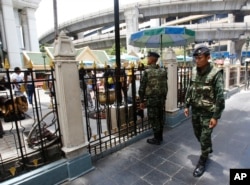A top Thai police official on Monday said authorities “are sure” Chinese tourists were not specifically targeted in the fatal bombing of a Bangkok shrine a week ago.
The site, the Erawan Shrine -- popular with Asian visitors to the Thai capital -- was most likely selected because it is a usually crowded location, said police Lt. Gen. Prawut Thavornsiri in response to a question from VOA.
The bomber was not a Buddhist or a Hindu because of the shrine’s syncretic nature, asserted the police general in remarks to foreign correspondents, characterizing the pipe bomb as being beyond the sophistication of bomb makers in Thailand.
“The bomb is a very perfect bomb, very high powered…it’s not easy to make a bomb like this,” said Prawut.
Two hours before the police official’s remarks at the Foreign Correspondents’ Club of Thailand, about 150 meters away at the Erawan Shrine a group of Buddhist monks chanted prayers for the souls of those who died, to mark one week since the blast.
Worshippers lit candles, burned incense and left offerings of jasmine flowers in front of a statue of Phra Phrom, the Buddhist representation of the Hindu god of creation, Brahma.
The monks and worshippers then fell silent for a moment at precisely 6:55 p.m., the time when the explosion killed and maimed shrine visitors.
At least 20 people died — including Thais, Chinese, Indonesians, Malaysians and Singaporeans — and more than 100 other people were wounded.
Massive search
Thousands of dwellings in Bangkok, including guesthouses frequented by foreigners, are being searched for clues in the bombing of the shrine, according to police.
There are more than 10,000 places in Bangkok that we have to inspect and search," said Metropolitan Police chief Lt. General Srivara Ransibrahmanakul. "We may also need to repeat searches at some places.”
Amid reports that some foreigners had been detained or arrested as part of the operation, General Prawut told reporters he did not how many people had been questioned and had no information on arrests.
An arrest warrant was previously issued for an unnamed man based on a sketch made from the CCTV images.
It is known that since the attack three people have been arrested: two Thais for spreading rumors on social media and a Hong Kong-based photographer, Hok Chun “Anthony” Kwan, for attempting to take body armor and a helmet on a flight back home from Bangkok after covering the aftermath of the bombing.
A statement from the Foreign Correspondents’ Club of Thailand (FCCT) declared it was “dismayed” by Kwan’s arrest and urged authorities not to press ahead with the criminal charges against the photographer, who could face five years in prison for violating the 1987 Arms Control Act.
“However, the use of body armor and helmets is routine by journalists around the world, and is clearly to enable them to do their jobs in dangerous situations. The deaths of two foreign journalists in Bangkok from gunfire during the political unrest in 2010 underscores the need for this kind of protection,” the FCCT said in a statement.
Those arrests have been criticized as misplaced priorities for authorities who are also under fire for a lack of progress in the case and issuing contradictory information.
Officials, speaking to reporters, have acknowledged they are uncertain whether the alleged bomber tracked on closed circuit television cameras was a Thai or a foreigner.
Identification hampered
A better identification of the suspect was hampered by broken CCTV cameras in central Bangkok along the main suspect’s escape route, national police chief General Somyot Poompunmuang said on Monday.
“We’ve had to waste time to put the dots together” because only about one-fourth of the cameras were functional, Somyot told reporters.
Authorities have contradicted themselves on whether or not the prime suspect was still likely in Thailand.
A British and a Thai newspaper have reported that motorcycle and tuk-tuk taxi drivers matched a customer with a copy of a passport photo they were shown for a “Mohamad Museyin.”
Khaosod newspaper reported the passport appeared to be a fake Turkish document.
That has led to speculation the attack was revenge for Thailand’s deportation early last month of more than 100 ethnic Uighurs to China.
Chinese authorities have labeled Uighur separatist movements as terrorist groups but none have been known to conduct any attacks outside China.
A Bangkok-based security analyst said authorities should take a close look at the far right pro-Uighur Turkish Grey Wolves (Ülkü Ocakları) for a connection to the Bangkok bombing.
Anthony Davis of IHS Jane’s Defense, also speaking at the FCCT on Monday, said the neo-fascist organization more closely fit the profile for involvement than offshoots of ISIS or Al Qaeda, which have no hesitation to claim responsibility for such attacks in various countries, usually carried out by suicide bombers.
No organization has made any claim of responsibility for the bombing at the Erawan Shrine.
Authorities are also investigating CCTV video showing a different man dropping a package into the Chao Praya River from the King Taksin bridge adjacent to Sathorn pier around the same time as the bombing of the shrine five kilometers away.
There was an explosion at that spot in the river the following afternoon but no one was injured.
Government officials initially rebuffed offers of international expertise to assist with the investigation of what they are terming the worst-ever bombing in Bangkok.
Police now say they do not have the desired sophisticated equipment and that "cooperation" from foreign countries would be welcome.
Other counties “use biometrics systems which consist of fingerprints, facial and iris recognition which Thailand doesn't have at the moment,” Somyot said on Monday.












